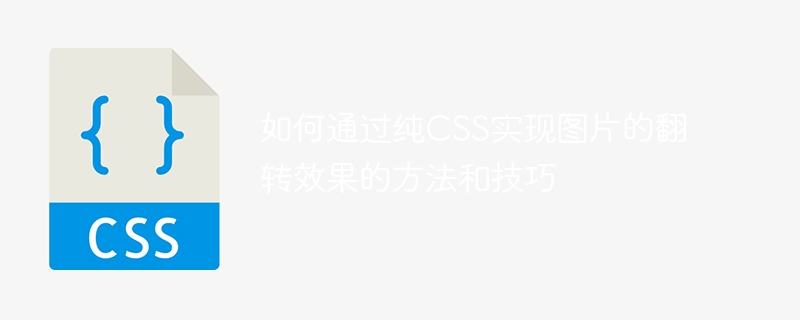

Methods and techniques on how to achieve image flipping effects through pure CSS
Foreword:
In web development, we often need to add some animation effects to web pages to enhance user experience. The flipping effect of pictures is one of the common effects. It is not only simple and convenient to realize the flipping of images through pure CSS, but also avoids the additional overhead caused by using other languages such as JavaScript. This article will introduce how to achieve the flip effect of images through pure CSS, and provide specific code examples.
1. Use the transform attribute of CSS3 to achieve image flipping
To achieve the flipping effect of images on a web page, we can use the transform attribute of CSS3. This attribute can change the shape of the element through various transformation functions, including rotation, scaling, translation and other effects. The following will introduce in detail how to use this attribute to achieve the flip effect of the image.
1.1 Basic structure and style
First, we need to add an element containing a picture to HTML and add a class name to it for style control. The code is as follows:
Next, we need to set some basic styles for this element in CSS, including width, height, border, etc. The code is as follows:
.image-container { width: 300px; height: 200px; border: 1px solid #ccc; perspective: 1000px; /* 设置透视效果,用于实现更逼真的翻转效果 */ }
Among them, the perspective attribute is used to set the perspective effect, which can make the flip effect appear more realistic.
1.2 Implementation of image flip effect
Next, we need to add a flip effect style to the image. The code is as follows:
.image-container:hover img { transform: rotateY(180deg); /* 鼠标悬停时,图片进行180度Y轴旋转 */ }
In the above code, we use the :hover pseudo-class to listen to the mouse hover event, and rotate the image 180 degrees around the Y axis through the rotateY function of the transform attribute.
Run the above code and you will see that when the mouse hovers over the image, the image will immediately flip 180 degrees. If you want to achieve a smoother transition effect, you can use the CSS transition property. The code is as follows:
.image-container { /* ... */ transition: transform 0.5s ease; /* 添加过渡效果 */ }
In the above code, we added a 0.5 second transition duration to the transform attribute through the transition attribute, and used the ease easing function to make the flip effect smoother.
2. Use the animation attribute of CSS3 to achieve image flipping
In addition to using the transform attribute, we can also use the animation attribute of CSS3 to achieve the flipping effect of the image. Compared with the transform attribute, the animation attribute can provide more animation effects and control options.
2.1 Basic structure and style
Similarly, we need to add an element containing a picture to the HTML and add a class name to it. The code is as follows:
In CSS, we also need to set some basic styles for this element, the code is as follows:
.image-container { width: 300px; height: 200px; border: 1px solid #ccc; perspective: 1000px; animation: flip-animation 1s infinite; /* 1s表示动画的时长,infinite表示动画无限循环 */ } @keyframes flip-animation { 0% {transform: perspective(1000px) rotateY(0deg);} /* 动画开始时的状态 */ 100% {transform: perspective(1000px) rotateY(180deg);} /* 动画结束时的状态 */ }
In the code, we use the @keyframes rule to define the key frames of the animation . Keyframes are expressed in percentage form, 0% represents the state at the beginning of the animation, and 100% represents the state at the end of the animation.
2.2 Controlling the triggering conditions of animation
In the above code, we set the animation attribute and set its value to flip-animation, which specifies which animation should be applied to the element. We can also specify animation trigger conditions through pseudo-class selectors, such as:hover pseudo-class or :checked pseudo-class, etc.
Code example:
.image-container:hover { animation-play-state: paused; /* 鼠标悬停时,暂停动画 */ } .input-checkbox:checked ~ .image-container { animation-play-state: running; /* 复选框选中时,开始动画 */ }
In the above code, we control the playback state of the animation through the animation-play-state attribute. paused means to pause the animation, and running means to start the animation. The :hover pseudo-class indicates mouse hovering, and the :checked pseudo-class indicates that the check box is selected.
Summary:
The flipping effect of images through pure CSS can be achieved through the transform attribute or animation attribute. The former controls the animation effect by setting the rotation angle, and the latter controls the animation effect through the definition of key frames. Using these methods and techniques, you can add more animation effects to your web pages and provide a better user experience.
Note: The above example code is based on the characteristics of CSS3 to achieve the flip effect of the image, so it may not display properly in some old browsers. In actual development, we need to consider browser compatibility and handle it accordingly.
The above is the detailed content of Methods and techniques on how to achieve image flipping effect through pure CSS. For more information, please follow other related articles on the PHP Chinese website!